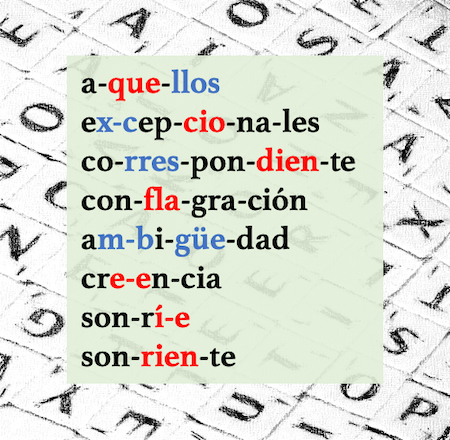17.2: División silábica
- Page ID
- 46530
\( \newcommand{\vecs}[1]{\overset { \scriptstyle \rightharpoonup} {\mathbf{#1}} } \)
\( \newcommand{\vecd}[1]{\overset{-\!-\!\rightharpoonup}{\vphantom{a}\smash {#1}}} \)
\( \newcommand{\dsum}{\displaystyle\sum\limits} \)
\( \newcommand{\dint}{\displaystyle\int\limits} \)
\( \newcommand{\dlim}{\displaystyle\lim\limits} \)
\( \newcommand{\id}{\mathrm{id}}\) \( \newcommand{\Span}{\mathrm{span}}\)
( \newcommand{\kernel}{\mathrm{null}\,}\) \( \newcommand{\range}{\mathrm{range}\,}\)
\( \newcommand{\RealPart}{\mathrm{Re}}\) \( \newcommand{\ImaginaryPart}{\mathrm{Im}}\)
\( \newcommand{\Argument}{\mathrm{Arg}}\) \( \newcommand{\norm}[1]{\| #1 \|}\)
\( \newcommand{\inner}[2]{\langle #1, #2 \rangle}\)
\( \newcommand{\Span}{\mathrm{span}}\)
\( \newcommand{\id}{\mathrm{id}}\)
\( \newcommand{\Span}{\mathrm{span}}\)
\( \newcommand{\kernel}{\mathrm{null}\,}\)
\( \newcommand{\range}{\mathrm{range}\,}\)
\( \newcommand{\RealPart}{\mathrm{Re}}\)
\( \newcommand{\ImaginaryPart}{\mathrm{Im}}\)
\( \newcommand{\Argument}{\mathrm{Arg}}\)
\( \newcommand{\norm}[1]{\| #1 \|}\)
\( \newcommand{\inner}[2]{\langle #1, #2 \rangle}\)
\( \newcommand{\Span}{\mathrm{span}}\) \( \newcommand{\AA}{\unicode[.8,0]{x212B}}\)
\( \newcommand{\vectorA}[1]{\vec{#1}} % arrow\)
\( \newcommand{\vectorAt}[1]{\vec{\text{#1}}} % arrow\)
\( \newcommand{\vectorB}[1]{\overset { \scriptstyle \rightharpoonup} {\mathbf{#1}} } \)
\( \newcommand{\vectorC}[1]{\textbf{#1}} \)
\( \newcommand{\vectorD}[1]{\overrightarrow{#1}} \)
\( \newcommand{\vectorDt}[1]{\overrightarrow{\text{#1}}} \)
\( \newcommand{\vectE}[1]{\overset{-\!-\!\rightharpoonup}{\vphantom{a}\smash{\mathbf {#1}}}} \)
\( \newcommand{\vecs}[1]{\overset { \scriptstyle \rightharpoonup} {\mathbf{#1}} } \)
\( \newcommand{\vecd}[1]{\overset{-\!-\!\rightharpoonup}{\vphantom{a}\smash {#1}}} \)
\(\newcommand{\avec}{\mathbf a}\) \(\newcommand{\bvec}{\mathbf b}\) \(\newcommand{\cvec}{\mathbf c}\) \(\newcommand{\dvec}{\mathbf d}\) \(\newcommand{\dtil}{\widetilde{\mathbf d}}\) \(\newcommand{\evec}{\mathbf e}\) \(\newcommand{\fvec}{\mathbf f}\) \(\newcommand{\nvec}{\mathbf n}\) \(\newcommand{\pvec}{\mathbf p}\) \(\newcommand{\qvec}{\mathbf q}\) \(\newcommand{\svec}{\mathbf s}\) \(\newcommand{\tvec}{\mathbf t}\) \(\newcommand{\uvec}{\mathbf u}\) \(\newcommand{\vvec}{\mathbf v}\) \(\newcommand{\wvec}{\mathbf w}\) \(\newcommand{\xvec}{\mathbf x}\) \(\newcommand{\yvec}{\mathbf y}\) \(\newcommand{\zvec}{\mathbf z}\) \(\newcommand{\rvec}{\mathbf r}\) \(\newcommand{\mvec}{\mathbf m}\) \(\newcommand{\zerovec}{\mathbf 0}\) \(\newcommand{\onevec}{\mathbf 1}\) \(\newcommand{\real}{\mathbb R}\) \(\newcommand{\twovec}[2]{\left[\begin{array}{r}#1 \\ #2 \end{array}\right]}\) \(\newcommand{\ctwovec}[2]{\left[\begin{array}{c}#1 \\ #2 \end{array}\right]}\) \(\newcommand{\threevec}[3]{\left[\begin{array}{r}#1 \\ #2 \\ #3 \end{array}\right]}\) \(\newcommand{\cthreevec}[3]{\left[\begin{array}{c}#1 \\ #2 \\ #3 \end{array}\right]}\) \(\newcommand{\fourvec}[4]{\left[\begin{array}{r}#1 \\ #2 \\ #3 \\ #4 \end{array}\right]}\) \(\newcommand{\cfourvec}[4]{\left[\begin{array}{c}#1 \\ #2 \\ #3 \\ #4 \end{array}\right]}\) \(\newcommand{\fivevec}[5]{\left[\begin{array}{r}#1 \\ #2 \\ #3 \\ #4 \\ #5 \\ \end{array}\right]}\) \(\newcommand{\cfivevec}[5]{\left[\begin{array}{c}#1 \\ #2 \\ #3 \\ #4 \\ #5 \\ \end{array}\right]}\) \(\newcommand{\mattwo}[4]{\left[\begin{array}{rr}#1 \amp #2 \\ #3 \amp #4 \\ \end{array}\right]}\) \(\newcommand{\laspan}[1]{\text{Span}\{#1\}}\) \(\newcommand{\bcal}{\cal B}\) \(\newcommand{\ccal}{\cal C}\) \(\newcommand{\scal}{\cal S}\) \(\newcommand{\wcal}{\cal W}\) \(\newcommand{\ecal}{\cal E}\) \(\newcommand{\coords}[2]{\left\{#1\right\}_{#2}}\) \(\newcommand{\gray}[1]{\color{gray}{#1}}\) \(\newcommand{\lgray}[1]{\color{lightgray}{#1}}\) \(\newcommand{\rank}{\operatorname{rank}}\) \(\newcommand{\row}{\text{Row}}\) \(\newcommand{\col}{\text{Col}}\) \(\renewcommand{\row}{\text{Row}}\) \(\newcommand{\nul}{\text{Nul}}\) \(\newcommand{\var}{\text{Var}}\) \(\newcommand{\corr}{\text{corr}}\) \(\newcommand{\len}[1]{\left|#1\right|}\) \(\newcommand{\bbar}{\overline{\bvec}}\) \(\newcommand{\bhat}{\widehat{\bvec}}\) \(\newcommand{\bperp}{\bvec^\perp}\) \(\newcommand{\xhat}{\widehat{\xvec}}\) \(\newcommand{\vhat}{\widehat{\vvec}}\) \(\newcommand{\uhat}{\widehat{\uvec}}\) \(\newcommand{\what}{\widehat{\wvec}}\) \(\newcommand{\Sighat}{\widehat{\Sigma}}\) \(\newcommand{\lt}{<}\) \(\newcommand{\gt}{>}\) \(\newcommand{\amp}{&}\) \(\definecolor{fillinmathshade}{gray}{0.9}\)| Saber dividir las sílabas ayuda a pronunciar y escribir las palabras correctamente. También es útil para decidir si una palabra necesita tilde (acento gráfico). |
 |
Knowing how to divide a word into syllables can help pronounce and spell words correctly. It is also helpful when it comes to deciding if a word needs a written accent. |
|
Una sílaba es un grupo de sonidos pronunciado alrededor de una o más vocales en una sola bocanada de aire. Por ejemplo, Pa-na-má tiene tres sílabas; cla-ro tiene dos; bien tiene una. Estas son las reglas básicas para dividir una palabra en sílabas: |
A syllable is a group of sounds which is pronounced around one or more vowels in a single breath of air. For example, Pa-na-má has three syllables; cla-ro has two; bien has one. Here are the basic rules for dividing a Spanish word into syllables: |
| 1. Siempre que sea posible, cada sílaba termina en vocal (cada consonante se une a la vocal siguiente): | 1. Whenever possible, syllables end in a vowel (each consonant is attached to the following vowel): |
| ca-ri-ño ¦ o-ro ¦ re-loj ¦ le-jos ¦ ge-ne-ra-li-da-des ¦ na-tu-ra-le-za ¦ lu-gar ¦ lu-ga-res ¦ e-xa-men ¦ ca-paz ¦ ca-pa-ces ¦ a-mi-ga | |
| 2. Las grafías dobles que representan un solo sonido, nunca se separan: ⟨ch⟩, ⟨ll⟩, ⟨rr⟩, ⟨qu⟩ (que, qui), ⟨gu⟩ (gue, gui) | 2. Never separate the following pairs of letters, because they represent only one sound: ⟨ch⟩, ⟨ll⟩, ⟨rr⟩, ⟨qu⟩ (que, qui), ⟨gu⟩ (gue, gui) |
| no-che ¦ ca-lles ¦ a-que-llos ¦ pe-rros ¦ gui-ta-rra ¦ pa-gue-mos ¦ re-qui-si-tos ¦ co-rre-la-ción | |
| 3. Dos consonantes consecutivas generalmente se separan en sílabas diferentes: | 3. Two consecutive consonants will generally belong to separate syllables |
| ac-ción ¦ nun-ca ¦ cuan-do ¦ cor-tar ¦ am-bi-guo ¦ al-can-zar ¦ en-ri-que-cer ¦ per-la ¦ al-go ¦ es-la-bón ¦ es-ca-lar ¦ hin-char ¦ ad-he-rir | |
| 4. ⟨r⟩ y ⟨l⟩ después de otras consonantes forman una unidad sonora y pertenecen a la misma sílaba (excepto después de ⟨n⟩ o ⟨s⟩). | 4. ⟨r⟩ and ;⟨l⟩ after other consonants form a sound unit and belong in the same syllable (except after ⟨s⟩ or ⟨n⟩). |
| ha-blar ¦ som-bri-lla ¦ con-tra-to ¦ ex-pli-car ¦ es-cla-vo ¦ a-dre-na-li-na ¦ con-fla-gra-ción ¦ A-tlán-ti-co ¦ si-glo ¦ com-prar | |
| 5. Si hay tres consonantes consecutivas, solo la tercera va con la siguiente vocal (excepto en las combinaciones mencionadas en el #4) | 5. When there are three consecutive consonants, only the third one is attached to the following vowel (except in the combinations mentioned in #4 above) |
| cons-tan-te ¦ ins-ti-tu-to ¦ PERO: tras-plan-tar ¦ som-bri-lla ¦ in-glés | |
| 6. Dos vocales abiertas (a, e, o) van en sílabas separadas, así como cualquier vocal duplicada: | 6. Two consecutive strong vowels (a, e, o), as well as any duplicate vowels, belong to separate syllables. |
| ma-es-tro ¦ te-a-tro ¦ co-o-pe-rar ¦ po-e-ta ¦ ca-os ¦ ta-re-a ¦ a-é-re-o ¦ lí-ne-a ¦ le-er ¦ chi-i-ta | |
| 7. Dos vocales cerradas (i, u) o una vocal cerrada átona junto a una abierta, forman una sola sílaba: | 7. Two weak vowels (i, u) or an unstressed weak vowel next to a strong one, form one single syllable. |
| bue-no ¦ rui-do ¦ ai-re ¦ can-ción ¦ ciu-dad ¦ trau-ma ¦ a-gua ¦ pin-güi-no ¦ so-cial ¦ vien-to ¦ cuan-do ¦ Eu-ro-pa ¦ se-ries ¦ Pa-ra-guay | |
| 8. Pero una vocal cerrada tónica y una abierta, van en sílabas separadas. | 8. But a stressed weak vowel and a strong one, belong to separate syllables |
| dí-as ¦ dú-o ¦ ma-íz ¦ ge-o-gra-fí-a ¦ o-í-do ¦ son-rí-en ¦ pa-ís ¦ tí-o ¦ ba-úl | |
| ► Explicación en inglés, audio y ejercicios: Spanishdict.com |
| ► Explicación detallada en español con ejemplos de audio: La sílaba (Wikcionario). |
Divida en sílabas las siguientes palabras. Modelo: acento → a-cen-to [Ejercicio interactivo] [Diccionario]
|
1. ocurrir: ____________________ |
6. institución: ____________________ |
11. frecuencia: ____________________ |
- Respuestas
-
1. o-cu-rrir 2. hie-rro 3. di-fe-ren-te 4. ar-qui-tec-tu-ra 5. tor-ti-lla
6. ins-ti-tu-ción 7. rei-no 8. com-ple-to 9. en-lo-que-cer 10. con-si-guien-te
11. fre-cuen-cia 12. ins-pi-ra-ción 13. a-e-ro-puer-to 14. lec-ción 15. ex-ten-sión

